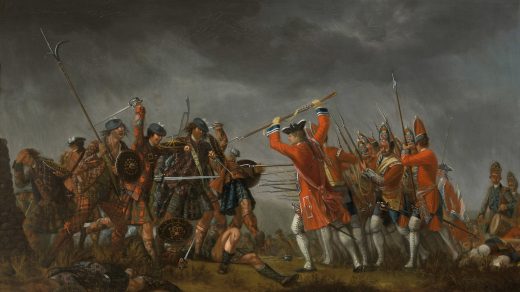Collapse of the clan system.
The clan system of the Highlands and Islands had been seen as a challenge to the rulers of Scotland from before the 17th century. James VI’s various measures to exert control included the Statutes of Iona, an attempt to force clan leaders to become integrated into the rest of Scottish society. This started a slow process of change which, by the second half of the 18th century, saw clan chiefs start to think of themselves as commercial landlords, rather than as patriarchs of their people. To their tenants, initially this meant that monetary rents replaced those paid in kind. Later, rent increases became common. 11–17 In the 1710s the Dukes of Argyll started putting leases of some of their land up for auction; by 1737 this was done across the Argyll property. This commercial attitude replaced the principle of dùthchas, which included the obligation on clan chiefs to provide land for clan members. The shift of this attitude slowly spread through the Highland elite (but not among their tenants).: 41 As clan chiefs became more integrated into Scottish and British society, many of them built up large debts. It became easier to borrow against the security of a Highland estate from the 1770s onwards. As the lenders became predominantly people and organisations outside the Highlands, there was a greater willingness to foreclose if the borrower defaulted. Combined with an astounding level of financial incompetence among the Highland elite, this ultimately forced the sale of the estates of many Highland landed families over the period 1770–1850. (The greatest number of sales of whole estates was toward the end of this period.): 105–107 : 1–17 : 37-46, 65-73, 131-132

The Jacobite rebellion of 1745 gave a final period of importance to the ability of Highland clans to raise bodies of fighting men at short notice. With the defeat at Culloden, any enthusiasm for continued warfare disappeared and clan leaders returned to their transition to being commercial landlords. This was arguably accelerated by some of the punitive laws enacted after the rebellion. These included the Heritable Jurisdictions Act of 1746, which removed judicial roles from clan chiefs and gave them to the Scottish law courts. T. M. Devine warns against seeing a clear cause and effect relationship between the post-Culloden legislation and the collapse of clanship. He questions the basic effectiveness of the measures, quoting W. A. Speck who ascribes the pacification of the area more to “a disinclination to rebel than to the government’s repressive measures.” Devine points out that social change in Gaeldom did not pick up until the 1760s and 1770s, as this coincided with the increased market pressures from the industrialising and urbanising Lowlands.: 30-31
41 properties belonging to rebels were forfeited to the Crown in the aftermath of the ’45. The vast majority of these were sold by auction to pay creditors. 13 were retained and managed on behalf of the government between 1752 and 1784.
The changes by the Dukes of Argyll in the 1730s displaced many of the tacksmen in the area. From the 1770s onwards, this became a matter of policy throughout the Highlands. The restriction on subletting by tacksmen meant that landlords received all the rent paid by the actual farming tenants – thereby increasing their income. By the early part of the 19th century, the tacksman had become a rare component of Highland society. T. M. Devine describes “the displacement of this class as one of the clearest demonstrations of the death of the old Gaelic society.”: 34 Many emigrated, leading parties of their tenants to North America. These tenants were from the better off part of Highland peasant society, and, together with the tacksmen, they took their capital and entrepreneurial energy to the New World, unwilling to participate in economic changes imposed by their landlords which often involved a loss of status for the tenant.: 50 : 173
Agricultural improvement was introduced across the Highlands over the relatively short period of 1760–1850. The evictions involved in this became known as the Highland clearances. There was regional variation. In the east and south of the Highlands, the old townships or bailtean, which were farmed under the run rig system were replaced by larger enclosed farms, with fewer people holding leases and proportionately more of the population working as employees on these larger farms. (This was broadly similar to the situation in the Lowlands.) In the north and west, including the Hebrides, as land was taken out of run rig, Crofting communities were established. Much of this change involved establishing large pastoral sheep farms, with the old displaced tenants moving to new crofts in coastal areas or on poor quality land. Sheep farming was increasingly profitable at the end of the 18th century, so could pay substantially higher rents than the previous tenants. Particularly in the Hebrides, some crofting communities were established to work in the kelp industry. Others were engaged in fishing. Croft sizes were kept small, so that the occupiers were forced to seek employment to supplement what they could grow.: 32-52 This increased the number of seasonal migrant workers travelling to the Lowlands. The resulting connection with the Lowlands was highly influential on all aspects of Highland life, touching on income levels, social attitudes and language. Migrant working gave an advantage in speaking English, which came to be considered “the language of work”.: 135, 110–117
In 1846 the Highland potato famine struck the crofting communities of the North and West Highlands. By 1850 the charitable relief effort was wound up, despite the continuing crop failure, and landlords, charities and the government resorted to encouraging emigration. The overall result was that almost 11,000 people were provided with “assisted passages” by their landlords between 1846 and 1856, with the greatest number travelling in 1851. A further 5,000 emigrated to Australia, through the Highland and Island Emigration Society. To this should be added an unknown, but significant number, who paid their own fares to emigrate, and a further unknown number assisted by the Colonial Land and Emigration Commission.: 201–202, 207, 268 : 320 : 187-189 This was out of a famine-affected population of about 200,000 people. Many of those who remained became even more involved in temporary migration for work in the Lowlands, both out of necessity during the famine and having become accustomed to working away by the time the famine ceased. Much longer periods were spent out of the Highlands – often for much of the year or more. One illustration of this migrant working was the estimated 30,000 men and women from the far west of the Gaelic speaking area who travelled to the east coast fishing ports for the herring fishing season – providing labour in an industry that grew by 60% between 1854 and 1884.: 335-336
The clearances were followed by a period of even greater emigration from the Highlands, which continued (with a brief lull for the First World War) up to the start of the Great Depression.: 2



